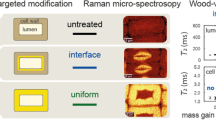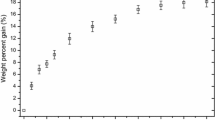Abstract
The aim of this study was to evaluate the effect that chemical modification by means of acetylation may have on juvenile vs mature pine sapwood. The results indicated that juvenile wood had clearly an adverse effect on acetylation; the magnitude of the reduction in WPG in juvenile wood was approximately 50% less than that of mature sapwood. The difference in the chemistry of the pyridine-catalysed acetylation vs the non-catalysed acetylation is thought to be responsible for this behaviour.
Zusammenfassung
In dieser Studie wird die Wirkung einer chemischen Modifikation mittels Acetylierung auf juveniles und adultes Kiefernsplintholz untersucht. Die Ergebnisse zeigen, dass die Acetylierung durch juveniles Holz eindeutig negativ beeinflusst wird. Der prozentuale Massezuwachs (WPG) bei juvenilem Holz lag um ca. 50% unter dem von adultem Splintholz. Dieses Ergebnis wird auf den chemischen Unterschied zwischen einer Acetylierung mit Pyridin als Katalysator und einer Acetylierung ohne Katalysator zurückgeführt.
Similar content being viewed by others
References
Banks WB, Lawther JM (1994) Derivatization of wood in composites. In: Gilbert RD (ed) Cellulosic polymers blends and composites. Hanser Gardner, New York, pp 115–155
Beckers EPJ, Militz H, Stevens M (1994) Resistance of acetylated wood to basidiomycetes, soft rot and blue stain. International Research Group on Wood Preservation, Document No. IRG/WP/94-40021
Browning BL (1902) Methods of wood chemistry. Interscience Publication, New York, Chapters 19, 25, 26
Eaton RA, Hale MDC (1993) Wood: Decay, Pests, Protection. Chapman and Hall, London, Chapters 1, 16
Hill CAS, Papadopoulos AN (2002) The pyridine catalysed acylation of sapwood and phenolic model compounds with carboxylic acid anhydrides. Determination of activation energies and entropy of activation. Holzforschung 56(2):150–156
Hon DNS, Bangi AP (1996) Chemical modification of juvenile wood. Part 1: Juvenility of Southern pine OSB flakes to acetylation. For Prod J 46(7–8):73–78
Kumar S (1994) Chemical modification of wood. Wood Fiber Sci 26(2):270–280
Meier H (1964) General chemistry of cell walls and distribution of the chemical constituents across the wall. In: Zimmermann MH (ed) The formation of wood in forest trees. Academic Press, New York, pp 137–151
Ohtani J (1986) Vestures in axial parenchyma cells. IAWA J 7(1):39–45
Panshin AJ, DeZeeuw C (1980) Textbook of wood Technology. 4th ed. Mc Graw-Hill, Inc, Chapter 7
Papadopoulos AN, Ntalos GA (2004) The effect of wood defects on chemical modification with acetic anhydride. Holz Roh- Werkst 62(5):395–396
Papadopoulos AN, Traboulay E (2002) Dimensional stability of OSB made from acetylated fir strands. Holz Roh- Werkst 60(2):84–87
Papadopoulos AN, Gkaraveli A (2003) Dimensional stabilization and strength of particleboard by chemical modification with propionic anhydride. Holz Roh- Werkst 61(2):142–144
Rowell RM, Tillman A, Simomson RM (1986) A simplified procedure for the acetylation of hardwood and softwood flakes for flakeboard production. J Wood Chem Technol 6(3):427–448
Rowell RM, Wang RHS, Hyatt JA (1986) Flakeboards made from aspen and southern pine wood flakes reacted with gaseous ketene. J Wood Chem Technol 6(3):449–471
Rowell RM, Imasura Y, Kawai S, Norimoto M (1989) Dimensional stability, decay resistance and mechanical properties of veneer-faced low-density particleboards made from acetylated wood. Wood Fiber Sci 21(1):67–79
Rowell RM (1983) Chemical modification of wood. Forest Prod Abstr 6:363–382
Author information
Authors and Affiliations
Corresponding author
Rights and permissions
About this article
Cite this article
Papadopoulos, A. Pyridine-catalyst acetylation of pine wood: influence of mature sapwood vs juvenile wood. Holz Roh Werkst 64, 134–136 (2006). https://doi.org/10.1007/s00107-005-0056-x
Published:
Issue Date:
DOI: https://doi.org/10.1007/s00107-005-0056-x




